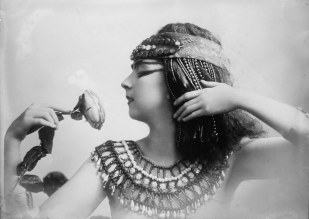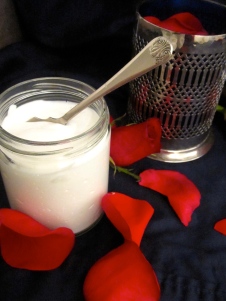 You may be familiar with rose water, whether you use it in skincare or cuisine, but I wanted to spend some time breaking down this delectable product since it has so many uses and has been favoured for thousands of years.
You may be familiar with rose water, whether you use it in skincare or cuisine, but I wanted to spend some time breaking down this delectable product since it has so many uses and has been favoured for thousands of years.
Cleopatra is said to have ordered the sails of her ship soaked in rose water so that Mark Antony could catch the scent of his lover before she reached the shores. Ancient ayurvedic physicians adopted the cooling properties of rose water to soothe wounds and inflamed skin. Sappho, the poet of love, deemed the rose as the “Queen of all Flowers”. Today, Persian and other middle eastern cuisines use rose water in food and drink, the French produce luxury bottles of perfumes and cosmetics, and even here in Toronto you can commonly find rose water toners and hydrosols in spas and on cosmetic counters.
What is it about this floral water that has captivated the entire globe for centuries? Well let me break it down for you :
Profile: The first record of rose petal distillation comes around the 10th century by a famous Persian alchemist. The steaming process used to isolate the rose’s essential oil creates a byproduct, which is rose water.
Rose petals are extremely high in anthocyanins which gives them the rich colour and is known to help repair and regenerate skin cells and tissues. Rose water aids in skin redness due to its anti-inflammatory and astringent quality. Rose water is not as potent as pure rose oil, but it is far more versatile.
Uses:
- Toner- I buy rose water in bulk and transfer it into a small glass spray bottle (easily found at any health food store). After cleansing, I use it to tone and hydrate, or at any time I feel like a refreshing spritz (this proves extremely useful in the summer months for cooling and reducing redness).
- After shower/ bath body spray- the fragrant water is perfect for leaving a light scent after the shower or a bath. It is refreshing and also moisturizing.
- Bath- add a cup or two to a bath as aromatherapy. Rose fragrance in aromatherapy is used as a relaxing scent to sooth feelings of depression and nervous tension.
My experience: There are a lot of expensive rose water products on the market, many of which are over priced. I have found that it is best to buy food-grade rose water which is commonly found at middle eastern food markets (the brand I love is from Lebanon). Just ensure that the ingredients say “distilled rose” with no additives, and if you can find it, organic is obviously the best.
If you are feeling experimental, try making your own.
Let me leave you with a lovely lotion recipe that has been getting rave reviews from my friends and family.
Rose Lotion
- 10g beeswax
- 1 1/4 cup of rose water
- 1 tsp vegetable glycerin
- 3/4 cup sweet almond oil (I mix half coconut oil with half sweet almond oil)
- 2 capsules of pure vitamin E
- 10 drops of rose or lavender essential oil
Method:
- Sanitize all equipment and jars before you begin (I boil everything).
- Using a double boiler (I place a glass measuring cup into a small pot of water), melt beeswax and oils together.
- Once melted, take off of heat, set aside and let cool until a light crust starts to form on top (approx. 5 minutes).
- In a blender, mix rose water and glycerin (just a few seconds until combined). After, keep the blender’s lid on but remove the centre circle and fit a small funnel.
- Next (to create an emulsion with the oil and water), turn blender on low and slowly pour a steady stream of oil/beeswax mixture through the funnel. When the blender motor begins to bog down, turn it up to the next speed. Continue this until you reach the highest speed and all oil is poured into the mixture.
- While the blender is still running, remove the lid and use a spatula to incorporate any water in the corners (be aware of the blender blade!)
- Once the water is absorbed, or the lotion becomes too thick to absorb any more water, turn off the blender. If any water remains unincorporated, pour off or blot with a tissue.
- Using the spatula, stir in the essential oil and vitamin E.
- Scoop into sterile jars
- Note: since this lotion has no preservatives and uses water- even though it is distilled- it has a greater chance of introducing bacteria, which shortens the shelf life. To help prevent this, do not stick fingers into jar, always wipe the rim before closing, and keep in a cool dark spot.
Enjoy the endless uses of rose water!
– Seanna




Hi, can I ask which brand of rosewater you buy and from where? I can’t seem to find any without additives – even at Whole Foods. Thanks!
Hi there! Seanna uses the ‘Cortas’ brand purchased from a Lebanese health store. The ingredient label only contains “distilled rose” and it is stored in the fridge for freshness. Lina makes her own rosewater by mixing 20 drops of Bulgarian rose oil in a half cup of filtered water. This is probably the purest approach per se, however the consistency varies… Hope that helps! 🙂